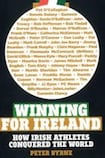
Some people remember growing up on a farm and being surrounded by animals. Others maybe by the sea, surrounded by boats. In our house it was athletics books and clippings and all sorts of athletics memorabilia.
My dad ran in the 1964 Olympics and reported on another seven. There were occasions we’d wake up to find an Olympic athlete sleeping in the spare bedroom. John Treacy, who went on to win the Olympic silver medal in the marathon in 1984, was one of them.
Athletics had got into our DNA, and from earliest memory gave a deep appreciation for the sport which more than any other first brought Ireland to international attention. We didn’t need to be told about O’Callaghan, Delany, Coghlan. They somehow entered the consciousness and stuck.
If there was a proper golden era it began not so much with Dr Pat O’Callaghan’s two Olympic gold medals in the hammer, in 1928 and 1932, but Ronnie Delany’s 1,500m gold in Melbourne in 1956, which inspired a trail of success, particularly in distance running, up to Sonia O’Sullivan’s Olympic silver over 5,000m in Sydney 2000.
This was the era during which Peter Byrne served as one of the leading reporters of Irish athletics, starting with the now-extinct Evening Mail in 1954, before joining The Irish Times in 1960, retiring 40 years later. He was colleague of my dad's, and although my early reporting days only briefly overlapped with his, Byrne's knowledge and insight of the sport was unquestionable. That's not said out of bias or friendship but simply because it's true.
This is what Byrne brings to Winning for Ireland, a thoroughly engaging read on many levels, starting with the troubled foundations of the sport, and the context for which it soon flourished. From the first athletics meeting in Dublin, in 1857, there were fractious times, including the fallout with the GAA, then the long-running rift between the 32-county athletics body, the NACA, and BLE, recognised internationally by the IAAF, before making peace to form the current governing body, Athletics Ireland, in 2000.
The Olympic dream
Three years in the writing, 23 chapters and 288 pages long, Winning for Ireland goes the pace and the distance, even with the success stories already told. Because more than just a recount of the Irish medallists, times or records, Byrne brings them back to life. With that comes a reminder that athletics was Ireland's first champion sport, something taken for granted in modern times thanks to the Ireland rugby team and now plethora of world-class golfers, rowers, boxers, occasional footballers, etc.
This began before its time, athletes such as John Flanagan unable to represent his country of birth: Flanagan “on his own admission was something of a home bird, a man who prized the peace and serenity of his native village, Kilbreedy, Co Limerick”, and was drawn to America not by the promise of employment, but rather “the allure of the Olympic dream”. He won the hammer in Paris 1900, St Louis four years later and in London 1908.
Diverse talents
Into this arena stepped Pat O’Callaghan, in 1928, a young doctor from close to Kanturk in Co Cork, and an “aura which had developed around him at a time when the emerging Irish Free State urgently needed cult figures to flesh out their towering idealism”. Byrne reminds us that O’Callaghan’s success in 1928, “The Irish Free State was less than seven years in existence”, when “Ireland didn’t have too many opportunities of showcasing its diverse talents on a major international stage… O’Callaghan’s triumph was one of the exceptions and to that extent, his achievement was in many respects, momentous”.
Delany, Olympic champion 28 years later, makes this observation in his foreword, noting the success of Irish athletes “helped raise the profile of the country at large and that is the measure of the importance of sport in projecting the image of a nation”. Delany also notes how some, perhaps lesser-known, Irish athletes – Noel Carroll, Frank Murphy, Ray Flynn – showcased Ireland to American people via the scholarship trail, “in a manner which was invariably of great credit to our country”, along with World Indoor gold medal winners Marcus O’Sullivan and Frank O’Mara.
Athletics also provided the arena for the pioneering women of Irish sport, from Maeve Kyle in 1956, before Sonia O’Sullivan and Catherina McKiernan became properly global superstars in the 1990s. Byrne brings these subjects and matter up to date, including the recent shift to Irish sprinting and hurdling success thanks to Derval O’Rourke and Thomas Barr. By the end, even for those of us already familiar with these stories, the reward is not just the reading of this book, but in the keeping of it.
















